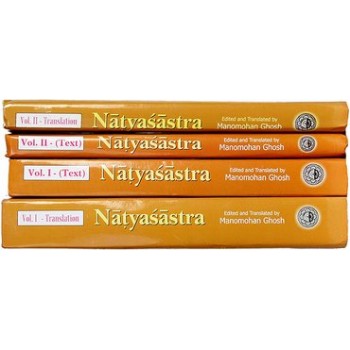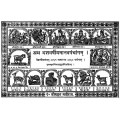NATYASASTRA OF BHARATA-MUNI
| Price: | Rs.2,600.00 |
Detail Of NATYASASTRA OF BHARATA-MUNI
| ISBN | 817080079X |
| Pages | 1346 |
| Language: | Sanskrit Text & English Translation |
| Size(in cm): | 9.7" X 6.4" cm |
| Weight(in grams): | 2900(approx) |
Description:
CONTENTS
VOLUME II (Text)
Title: NATYASASTRA (ASCRIBED TO BHARATA-MUNI VOLUME-II)
CONTENTS
VOLUME III (Text)
Title: NATYASASTRA (ASCRIBED TO BHARATA-MUNI VOLUME-III)
XVIII. Rules on the Use of Languages
Preface to the Second Editions viii
Abbreviations and Symbols xi
INTRODUCTION
I. THE PRESENT WORK xvii
1. Scope and Importance of the Ns. xix
2. A Short History of the Study xix
2a. The Basic Text xxiii
3. Difficulties of the Translation xxiv
4. Form of the Translation xxiv
5. Notes on the Translation xxv
II. THE ANCIENT INDIAN THEORY OF DRAMA xxvi
1. Meaning of Natya xxvi
2. Four Aspects of Drama xxviii
3. The Theory of Imitation xxix
4. The Dramatic Conventions xxx
5. Time and Place in Drama xxxii
6. The Unity of Impression xxxii
7. Criticism of Drama xxxiii
8. The Theory of Sentiments (rasa) xxxv
III. THE LITERARY STRUCTURE OF DRAMA xxxix
1. Two Major Types of Play xxxix
(a) Subject-matter and division into Acts, p. xI; (b) Explanatory Devices, P. xIii; © The Plot and its Development, p. xIiii.
2. Eight Minor Types of Play, xIiv
3. The Characterization in a Play xIvi
4. Diction of a Play xIvii
IV. ANCIENT INDIAN DRAMA IN PRACTICE xIix
1. Occasion for Dramatic Performance xIix
2. Time for Performance 1
3. The Playhouse or the Theatre Ii
4. Representation Iii
(a) Physical Representation, p. Iiii; (b) Music accompanying the foot-movements, p. Ivi; © Vocal Representation, p. Ivii; (d) Costumes and Make-up, p. Ivii; (e) The mise-en scene, p. Iviii.
V. DATE OF THE NATYASASTRA Iix
VI. DATE OF INDIA'S CULTURAL HISTORY Ixv
1. Geography Ixvi
2. Ethnography Ixvi
3. Languages Ixvi
4. Literature Ixvi
5. Costumes and Ornaments Ixvi
6. Art Ixvii
7. Ars amatoria Ixviii
8. The Arthasastra Ixviii
9. Psychology Ixviii
THE TRANSLATION
I. Origin of Drama 1
II. Description of the Playhouse 18
III. Puja to the Gods of the Stage 33
IV. Description of the Class-dance 45
V. Preliminaries of a Play 76
VI. Sentiments (rasa) 100
VII. Emotional and other States 119
VIII. Gestures of Minor Limbs 150
IX. Gestures of Hands 172
X. Gestures of other Limbs 194
XI. Cari Movements 200
XII. Mandala Movements 210
XIII. Different Gaits 216
XIV. Zones and Local Usages 242
XV. Rules of Prosody 253
XVI. Metrical Patterns 265
XVII. Diction of a Play 297
321
XIX. Modes of Address and Intonation 333
XX. Ten Kinds of Play 353
XXI. Limbs of the Segments 378
XXII. Styles 401
XXIII. Costumes and Make-up 417
XXIV. Harmonious Representation 442
XXV. Dealings with Courtezans 486
XXVI. Varied Representations 497
XXVII. Success in Dramatic Representation 515
Appendix 531
Bibliography 535
Corrections and Additions 538
Correction and Additions to vol. II 543
Index 546
Index to vol. II 570-587
CONTENTS
VOLUME IV (Text)
Title: NATYASASTRA (ASCRIBED TO BHARATA-MUNI VOLUME-IV)
PREFACE TO THE SECOND EDITION:
Though there was a constant demand for it, the translation of the Natyasastra vol. I (I-XXVII) which was out of print in 1959, could not be published earlier for a variety of reasons. The most important of these was that the text which was reconstructed earlier and made the basis of translation, had to be revised very carefully after a study of the materials which accumulated during the years following its publication. These include not only the volumes III and IV of the Baroda edition of the Natyasastra, but also some other works. Among these latter mention should be made of Dr. Indu Shekhar's Sanskrit Drama (Leiden, 1960) in which he has made an up to date study of certain aspects of the history of ancient Indian theatre. This work based on all available materials is highly suggestive, and will prove useful to scholars. The next work of importance is an annotated translation of the Nataka-laksana-ratnakosa by Professor Dillon and others (Transactions of the American Philosophical Society, New Series vol. 50, Part 9. Philadelphia). It is a meritorious work. Besides, it shows clearly to what extent a text compiled in the lines of the Natyasastra more than six centuries before our time, has become unintelligible. From the fact that the three learned authors of this work could not be unanimous on a number of points, one will easily appreciate the difficulty of editing and interpreting the basic work which was compiled most probably more than two milleniums ago. Besides these works, there are a few articles Publication of the present author's critical text of the Natyasastra vol. II (XXVII-XXXVI) has also made the revision more fruitful. It may be mentioned here that due to the very corrupt nature of this part of the text treating of music and some aspects of theatre, it was not possible to prepare earlier a tolerably critical version of this; and at one stage of the work, it was seriously thought that the attempt should be given up. But fate willed otherwise. After a second thought I reconciled myself with the sorry state of the MSS, as well as printed materials, and decided to place the results of my studies, however, imperfect they might be, at the disposal of scholars.
It was regretted in the beginning that due to serious reasons the vol. I of the text could not be issued in 1951 along with the translation. For, the text not being available, scholars were very much handicapped in using the translation, although the essential variants as well as sources from which the text was made out, had been mentioned in the footnotes more or less in detail. Now having revised the unpublished critical text (issued in a separate volume) I have no longer any complaint that the publication was delayed so long, Readers, I may hope, will have at present a better work. As for the first edition of the translation, this can be said that in spite of its drawbacks due chiefly the comparative inadequacy of the basic text, it has not been altogether fruitless. For, the extent to which it has stimulated during the last sixteen years the study and researches in the Natyasastra, may be considered a sufficient defence for its publication.
I may now feel quite happy to place before the scholar a second edition of the translation. Though obstacles in the way of this undertaking have been many and various, I have tackled with them as best as I could, and may hope that the scholars will have this time a better facility not only to assess the value of my work, but also to make, f they would like, new contributions to the study, of which there will be some scope, for a long time.
In the present Introduction some paragraphs have changed their places and new ones have been added. And some portions of it have been transferred to the Introduction to the text. Bur for the convenience of the readers of the present volume, the discussion on the date of the work, which form an intregral part of the critical edition of the text, has been briefly repeated here. This may be justified on the assumption that the readers who would study the Natyasastra through a translation only, are likely to be quite thoroughly revised, and attempt has been made here and there, to throw some fresh light on certain aspects of the ancient Indian theatre and dramaturgy, which escaped the author's attention earlier. To render this volume more useful two indexes have also been added. It may be repeated that the present work is likely to be more helpful to readers. But in spite of this assumption, the author knows the limitation of his work which had to be carried on unaided under difficult circumstances. He will be amply rewarded if the present edition of the translation would sustain for some time the interest of readers who are aware of the great value of India's culture.
Calcutta, 14-5-67
The translator
Reviews (0)
Write a review
Your Name:Your Review:
Note: HTML is not translated!
Rating: Bad Good
Enter the code in the box below:
Recently Viewed



 |
| 
